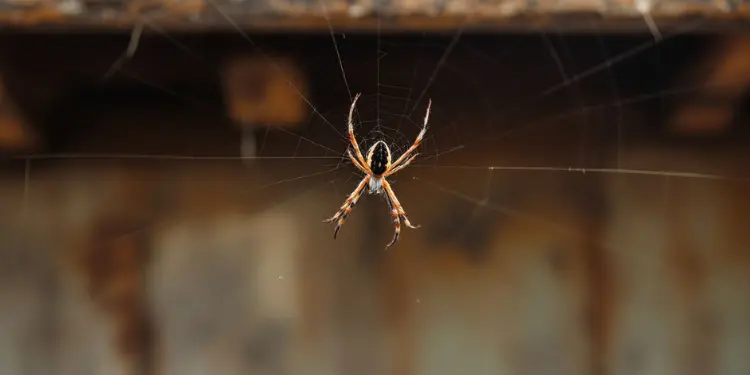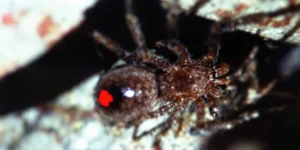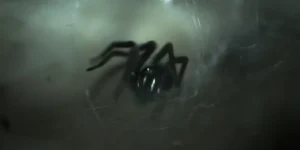Redback spiders concern many Australians. These small arachnids deliver a painful bite. This post presents ten redback spider facts to inform and enhance safety. This Redback Spider Facts information will increase your knowledge about these well-known Australian spiders.
Key Takeaways
- Redback spiders are common in Australia, with females being larger and more dangerous than males. Their venom contains alpha-latrotoxin and can be lethal.
- These spiders often live near homes in dry, hidden spots. They’ve spread to other countries like New Zealand and Japan through shipping.
- Female redbacks can live for 2-3 years and make up to 10 egg sacs, each with about 250 eggs. No one has died from a redback bite since 1956 when antivenom was introduced.
- Redbacks have natural enemies like daddy-long-legs spiders and spider wasps. They’re similar to black widow spiders but have different markings and live in different parts of the world.

Redback Spider Facts: Female vs Male Redback Spiders

Female and male redback spiders have distinct appearances, larger and pose a greater threat than their male counterparts.
Detailed Characteristics of Male Redback Spiders
Male redback spiders are small creatures. They measure just 3-4 mm long, about the size of a grain of rice. These small spiders have light brown bodies with a pale hourglass shape on their backs.
Unlike their female counterparts, male redbacks don’t have bright red markings. Their colours are softer and less noticeable.
These small arachnids are significant in Australian wildlife. They’re part of the venomous spider family, but male redbacks are less harmful than females. Their venom isn’t as potent.
It’s wise to be cautious around any spider you encounter in Australia.
Redback Spider Facts: Redback Spider Habitat
Redback spiders frequently inhabit areas close to human dwellings. They establish their habitats in dry, secluded locations around houses and yards. They are commonly found beneath rocks, within logs, or concealed in sheds and outdoor toilets.
These arachnids also favour debris piles and shrubs.
These spiders are widespread throughout Australia. They are primarily nocturnal and less prevalent during winter months. Redbacks have expanded their range to other countries as well.
Redback Spider Facts: Venom and Its Effects
Moving from where redback spiders live, let’s examine their venom. Redback spider venom is highly potent. It contains a toxin called alpha-latrotoxin. This toxin affects the nerves and can be lethal.
Female redbacks possess more potent venom than males. The lethal dose for female venom is minuscule – just 0.08 to 0.10 mg. For mice, it takes 0.27 to 0.91 mg per kg of body weight to be fatal.
In Australia, redbacks bite 2,000 to 10,000 people each year. About 250 of these cases require antivenom. Fortunately, no one has died from a redback bite since 1956. That’s when doctors began using antivenom to treat bites.
Life Cycle and Reproduction
Redback spiders have a short but busy life. Female redbacks live for 2-3 years, while males only last 6-7 months. Females take about 4 months to grow up, but males mature faster in just 3 months.
A female can make up to 10 egg sacs in her life. Each sac holds about 250 eggs, but this can range from 40 to 500. The eggs hatch in 2-4 weeks.
Baby spiders often eat each other after hatching. This helps the strongest ones survive. Female redbacks can store sperm for up to 2 years. This allows them to make egg sacs even when no males are around.
Less than 20% of male redbacks find a mate. Most die soon after mating. Here are some additional facts about these spiders.
Supplementary Facts on Redback Spiders
Redback spiders have some unexpected characteristics. They can live up to two years, consume their mates, and endure without food for months. Continue reading to discover more about these intriguing Australian arachnids.
Predators and Natural Enemies
Redback spiders have several natural predators. Daddy-long-legs spiders and white-tailed spiders frequently hunt and consume redbacks. Spider wasps, such as Agenioideus nigricornis, also target these arachnids.
These wasps sting and immobilise redbacks, then deposit eggs on their bodies. Upon hatching, the wasp larvae feed on the spider.
Redback eggs are also vulnerable. Lacewings and certain wasp species feed on redback egg sacs. These small predators can eliminate entire clutches of eggs before they hatch. The natural balance maintains redback populations through these predator-prey relationships.
The following section examines historical methods for treating redback spider bites.
Redback Spider Facts: Historical Treatment of Bites
Early redback spider bite treatments were ineffective. Doctors attempted incisions at the bite site, applying tourniquets, or attempting to extract venom orally. These approaches were largely unsuccessful and frequently caused additional harm.
Unfortunately, at least 14 fatalities occurred due to bites before an effective treatment was developed.
In 1956, a significant improvement occurred. The Commonwealth Serum Laboratories produced an antivenom that proved life-saving. This new treatment marked a substantial advancement in spider bite management.
It transformed redback bites from potentially fatal to treatable, significantly improving safety for Australians.
Redback Spider Distribution
Redback spiders are native to Australia. They primarily inhabit arid regions of South and Western Australia. These adaptable arachnids have also spread to other locations. In the 1980s, they appeared in New Zealand.
During the 1990s, they reached Japan and the UAE. Currently, they can be found in Belgium, England, the Philippines, and India.
The global spread of these Australian spiders is largely due to their ability to conceal themselves in cargo. International shipping and air freight transport goods worldwide. Redbacks find their way into boxes and containers.
Subsequently, they establish new colonies far from their original Australian habitat. This unintended global distribution is concerning for local ecosystems and residents in these new areas.
Comparison of Redback Spider and Black Widow Spider
Redback spiders and black widows share many traits, but they have key differences. These two spiders compare as follows:
| Feature | Redback Spider | Black Widow Spider |
|---|---|---|
| Scientific Name | Latrodectus hasselti | Latrodectus mactans |
| Appearance | Black/brownish with red/orange stripe | Shiny black with red hourglass marking |
| Size | Females: 1 cm body length | Females: 1.5 cm body length |
| Habitat | Urban and disturbed areas | Urban and disturbed areas |
| Venom | Neurotoxic | Neurotoxic |
| Distribution | Australia, Southeast Asia | North and South America |
Both spiders belong to the same genus, Latrodectus. They have similar habits and prefer urban settings. Their venom is alike, causing pain and other symptoms in humans. The main difference is their appearance and location. Redbacks have a red stripe, while black widows sport a red hourglass. Redbacks are found in Australia, but black widows live in the Americas.
For more information on redback spiders, visit RedBackSpider.com.
Safety Tips for Australians
Staying safe around redback spiders is essential for Australians. Here are some important tips to keep you and your family protected:
- Wear gloves and closed shoes when gardening or working outdoors. This protects your hands and feet from spider bites.
- Inspect and shake out clothing, shoes, and gloves before putting them on. Spiders often hide in dark, quiet spots.
- Educate children about spider dangers and safe habits. Show them how to spot webs and avoid risky areas.
- Maintain a tidy yard. Remove piles of wood, rocks, and clutter where spiders tend to live.
- Install insect screens on windows and doors. This helps prevent spiders from entering your home.
- If bitten, apply an ice pack to the bite area immediately. Avoid using pressure bandages, as this can worsen the situation.
Redback Spider Facts: Meet the Australian Latrodectus Hasselti
RedBackSpider.com presents an in-depth look at the redback spider, scientifically named latrodectus hasselti. This blog post is worth reading because it explains how these spiders build spider webs, capture prey, and why they remain a hot topic in Australian environments.
Redback Spider Facts: Where Do They Live?
Red-back spider sightings often occur near garage corners or dark areas with plenty of dry silk. Their nest can contain egg sacks between september and may, sometimes totalling 300 eggs.
Redback Spider Facts: Is It Closely Related?
Yes, the redback spider is one of the species of latrodectus, making it closely related to other widow variants. Female redback spiders are black to brown, with a bright red to orange stripe on the abdomen.
Red-Back Spider: How Big?
Females measure about the size of a large pea, while the male’s body can be 3mm. White markings can appear on juveniles. The stripe on the upper abdomen or markings on the upper side help identify them.
Redback Spider Facts: What About Prey?
They hunt small lizards, insects, and sometimes practise cannibalistic behaviours: spiderlings can be eaten by their siblings. Female redback spiders are black and wait in a tangle of silk threads for unsuspecting prey.
Red-Back Spider: Danger?
Their fang injects venom that can lead to nausea and vomiting. Bites may cause pain and swelling near the bite site.
Red-Back Spider: Any Snake Connection?
While not directly linked to snake species, they inhabit the same urban areas, including garden sheds, logs, or near stored goods.
Red-Back Spider: Reproduction
Female redback spiders lay egg sacks between september and May, containing hundreds of embryos that can hatch within four months.
Redback Spider Facts: Is Anti-Venom Available?
Yes, an anti-venom helps relieve severe envenomation. Prompt care is recommended if symptoms worsen.
Red-Back Spider: Summarising Key Data
| Feature | Details |
|---|---|
| Abdomen Color | Black to brown, sometimes white markings |
| Typical Size (Female) | Size of a large pea |
| Known Prey | Insects, small lizards |
| Behaviour | Can be cannibalistic (siblings) |
Main Takeaways:
- Latrodectus hasselti is a well-known redback spider in Australia.
- Females have a red to orange stripe on the abdomen.
- Avoid hiding places like a garage packed with clutter.
- Prey includes insects and sometimes small lizards.
- Seek medical attention if nausea or severe bite site reactions appear.
Conclusion
Redback spiders are a part of Aussie life. We’ve learned ten key facts about these tiny but mighty creatures. From their unique mating habits to their potent venom, redbacks are full of surprises.
Knowing these facts helps us stay safe and respect these spiders. This information can help us live smartly with our eight-legged neighbours.
For more detailed insights on the intriguing characteristics of male Redback Spiders.
FAQs
1. Are redback spiders really that dangerous?
Yeah, mate, these little critters pack a punch… Their venom’s potent, but deaths are rare these days. Still, a bite can make you pretty crook – best to steer clear and get help if you cop one.
2. Where do redbacks like to hang out?
These sneaky buggers love dark, dry spots. You’ll find ’em under logs, in sheds, or even in your dunny! They’re not fussy… just about anywhere sheltered will do. Keep an eye out when you’re poking around outside.
3. How can I tell if I’ve been bitten by a redback?
If a redback’s had a go at you, you’ll know it. The pain’s intense and spreads fast. You might feel sick, sweat buckets, and get the shakes. Don’t muck about – if you reckon you’ve been bitten, get to a doc quick smart.
4. Can redbacks kill my pets?
Redbacks can give your furry mates a hard time, for sure. Small pets are at most risk… cats and dogs might pull through, but it’s no picnic. Best to keep your yard tidy and check your pet’s bedding to avoid any nasty surprises.





